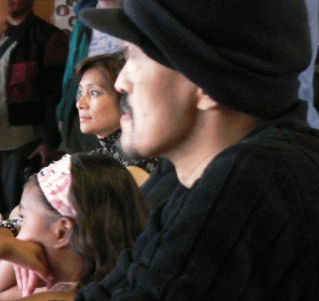Tuesday, August 29, 2006
Events Calendar Added To Sidebar
Recently there's been an increase in notices for upcoming FMA events, so I've added a calendar to the Links section (on the right) for convenience. Events listed there can take you directly to the announcements. Check regularly for updates!
Monday, August 28, 2006
Sonny's Carvings
Most people have never had the chance to see Sonny's amazing carvings, so I linked some images through this webpage. The level of detail is astounding, and this is typical of the thousands of pieces he did, each one unique.
* I updated this entry the day after Sonny's memorial to include pictures of knives on display there.
* I updated this entry the day after Sonny's memorial to include pictures of knives on display there.
Friday, August 25, 2006
Arrangements for Sonny
Thanks to all who have expressed condolences at the passing of master Sonny Umpad.
Here are the arrangements for Sonny's memorial service, as per the the wishes of his childred Jackie and Brian:
Friday, September 1, 2006. Services will begin at 7:00 pm.
Wedgewood Banquet Center at Metropolitan Golf Links
10051 Doolittle Drive
Oakland, CA 94603
(510) 569-5556
An obituary has been placed in the Oakland Tribune Thursday, August 31st. There is a guestbook there so people can leave their thoughts and comments. This will be available through the end of September (unless a 1 year or permanent entry is purchased). I have also put a copy of the obituary here.
This evening Sonny's daughter Jackie informed me a short obituary notice did appear in the SF Chronicle. The guest book is the same one used by the Tribune, for those who wish to sign it.
Here are the arrangements for Sonny's memorial service, as per the the wishes of his childred Jackie and Brian:
Friday, September 1, 2006. Services will begin at 7:00 pm.
Wedgewood Banquet Center at Metropolitan Golf Links
10051 Doolittle Drive
Oakland, CA 94603
(510) 569-5556
An obituary has been placed in the Oakland Tribune Thursday, August 31st. There is a guestbook there so people can leave their thoughts and comments. This will be available through the end of September (unless a 1 year or permanent entry is purchased). I have also put a copy of the obituary here.
This evening Sonny's daughter Jackie informed me a short obituary notice did appear in the SF Chronicle. The guest book is the same one used by the Tribune, for those who wish to sign it.
An Homage to Sonny Umpad
Here are some thoughts about Sonny now, while they’re still fresh, kind of like a signpost to mark where we are at his passing. In ten years, I hope we can look back and see how his influence has spread in the FMA community.
Yesterday I called Sonny a giant, though few actually met him. He was a very private man, and for years rarely took his art outside of his home, preferring to let those whom he trusted come to him. Thus his legacy will someday be better known through those who propagate his teachings rather than directly by his hand.
Some of those are folks who trained with Bruce and James Yimm Lee, such as Jesse Glover in Seattle and Gary Cagaanan in Oakland. Others are younger notables in the martial arts such as Kelly Worden in Tacoma and Alfred Plath in Germany. Most, however, are a new generation of martial artists just coming of age now, entering their prime years blessed with the deep knowledge of a master teacher.
Sonny was a bridge across generations in the arts. Growing up in the Philippines, he experienced first-hand the art in its native setting. He was a witness to history, crossing paths with some of the greats most of us only know from reading about them, but perhaps the greatest aspect of his legacy was his knowledge gained from the streets. Sonny knew more about what he called “the dark side” of the arts than just about anyone I’ve known, but to his credit he lived a life in the light, focusing on laughter and the beauty in the art. Before he emerged in the martial community, he was, like Bruce Lee, a champion cha-cha dancer, and he brought those skills into the Corto Cadena style he created.
Sonny’s genius was that he took disparate elements of the Filipino arts and re-integrated them into a comprehensive whole. More than just that, however, he synthesized those elements to create something uniquely his. His earliest influences seemed to be Balintawok, which was prominent where he grew up in Cebu. Some of his early formal training was with Cacoy Canete and later with Raymond Tobosa in Hawaii (as I recall). In California he rubbed shoulders with legends like Angel Cabales. He took something from each but wasn’t limited to merely imitating. He examined each element of his art critically, ensuring it had value towards his goal.
When I first met him back in 1986, through a seminar at Joe Olivarez’ U.S. Karate in Hayward, Sonny was unveiling perhaps the first of his unique innovations, the centerline roll for double sticks, based on Wing Chun’s circular punching. Unlike most double stick, which is taught by learning numerous patterns and pairing them up, this was genius in its simplicity. By merely mastering this single technique, one could match up against any strike using either hand in a continuous barrage. Still, as easy as it looks and sounds, few could do it with the speed and precision Sonny applied to his art, and his understanding of leverage generated power that belied his slight physique.
I spent perhaps the most time with Sonny in the early 1990’s, after Angel Cabales passed away. He and Angel met only infrequently but had a warm relationship, sharing roots in the same locales and slipping back into the old dialects of their youths. As the younger man, Sonny affectionately called Angel “Doh,” uncle. Angel used to say many people stole his ideas, though many wouldn’t acknowledge it. Sonny was upfront, giving me his famous line that “if you’re going to steal, do it from the best.” His affinity for Angel’s material is not surprising, given the Cebuano roots of both their arts.
Around this time Sonny was working on his sikaran, the low kicking art developed to work in conjunction with weapons, as opposed to the high flashy kicks common to many popular modern arts. Sonny would test his ideas out on me and I’d share my variations on these themes from my years in Kenpo. Even then, however, it was apparent that Sonny was working from a very different source, drawing inspiration for his low body movement and turned-out stepping from Moro-Moro sayaw. With great natural flexibility and dancer's fluidity, Sonny had an ability to come from unusual angles. It was in the sikaran that I began to see the functionality of his pendulum movement, which allowed him to strike while seemingly out of range.
It was this confluence of the Moro and Cebuano arts that marked the emergence of the next phase of Sonny’s body of work, and that was his knowledge of the blade. As with all other aspects of his work, this was something nurtured from careful analysis. The blade is enmeshed with Filipino culture, and so having been raised there, Sonny had insights that lent themselves to appreciation of edged weapons without the romanticism with which less experienced folk often hold them.
Sonny’s creative genius went beyond just movement, extending also to the artifacts he created in conjunction with his art. Anyone who ever visited him had to be impressed by the array of weaponry adorning the walls of his home, all crafted by his hand. From elaborately carved rattan sticks to beautifully designed traditional weapons in wood and metal, Sonny was a master artisan. He was also prolific, and eventually every bit of his home was filled with his work, making it a veritable museum of Filipino martial culture. In every corner one could find unusual devices, like his impenetrable armor vest for “breaking in” students on the knife, the racks of fiberglass training fencing foils, or his swinging pendulum and various sparring targets.
This was a man who lived life fully. I’ve always had a hard time imagining how he fit so much into the moments of each day. I marvel at how it seemed that every visit to his home revealed a new facet of his personality, such as his passion for playing and writing music on the keyboard and recording it on his four-track. I was amazed by his rebuilt acoustic guitar with the tuning head moved into the body, which I’d never seen in 35 years as a player.
It is my everlasting regret that I didn’t spend more time with Sonny. Part of it was reluctance to take advantage of his generosity. There wasn’t a time I visited that he didn’t want to show me what he was working on. I realized that he shared much more with me than I could offer back, but when I suggested I start taking lessons as his student, he smiled and said we were contemporaries. In that he was overly generous, and in my embarassment I stopped coming by so often. Still, I found other ways to try to repay him, such as helping market his innovative padded training sticks or helping hook up prospective students.
Some of those are my seniors in Serrada, such as masters Wade Williams and Carlito Bonjoc, and many others are faces and names I am only now starting to put together. It is through the imprint of Sonny’s movement and knowledge that I see his art living on, and hopefully through them I will finally take the time for more of those lessons I missed along the way. I’m sure I’m not alone in this, for there were so many facets and phases along the arc of Sonny’s career that many of us only got what was currently his passion, and so it is important that we share.
Those who came later were fortunate to reap the benefit of all that had gone on before. Sonny wasn’t merely a caretaker but a builder, and those who absorbed even a part of his spirit have come away with something uniquely different. His is not a cookie cutter style of stick fighting, but something that transformed people to the core of their being, and just as Sonny was a generous soul, so I see this shining from the faces of those who were attracted to him.
We are fortunate that Sonny left such a huge legacy in the form of his recordings. There was always videotape rolling, whether recording students’ lessons or playing them back on the tv. Sonny was someone with great affinity for modern technology and he used it more than anyone else I know. Perhaps someday some of his vast library of recordings can be made available for study. It is an invaluable resource, and one that should be both preserved and shared for posterity.
In the meantime, the art is a living thing, passed from hand to hand, and so it is up to this next generation to move forward in their own personal development and as teachers. What I see in them is kindred to Sonny, a humbleness of spirit combined with skill, intelligence and determination.
I recall the words of Gilbert Tenio following the funeral for his old contemporary Angel Cabales, that the art was not meant to compete with each other, but to ensure mutual survival. It is a bond of brotherhood, and the words of this manong were meant to guide us to appreciate what we share in common. The love we have for our teachers, and above that our passion for what we do, is something greater than differences of opinion or ego. This is something Sonny understood, and he always saw the best in people. As long as this principle is at the forefront, the art will flourish and be strong, keeping the chain alive.
Yesterday I called Sonny a giant, though few actually met him. He was a very private man, and for years rarely took his art outside of his home, preferring to let those whom he trusted come to him. Thus his legacy will someday be better known through those who propagate his teachings rather than directly by his hand.
Some of those are folks who trained with Bruce and James Yimm Lee, such as Jesse Glover in Seattle and Gary Cagaanan in Oakland. Others are younger notables in the martial arts such as Kelly Worden in Tacoma and Alfred Plath in Germany. Most, however, are a new generation of martial artists just coming of age now, entering their prime years blessed with the deep knowledge of a master teacher.
Sonny was a bridge across generations in the arts. Growing up in the Philippines, he experienced first-hand the art in its native setting. He was a witness to history, crossing paths with some of the greats most of us only know from reading about them, but perhaps the greatest aspect of his legacy was his knowledge gained from the streets. Sonny knew more about what he called “the dark side” of the arts than just about anyone I’ve known, but to his credit he lived a life in the light, focusing on laughter and the beauty in the art. Before he emerged in the martial community, he was, like Bruce Lee, a champion cha-cha dancer, and he brought those skills into the Corto Cadena style he created.
Sonny’s genius was that he took disparate elements of the Filipino arts and re-integrated them into a comprehensive whole. More than just that, however, he synthesized those elements to create something uniquely his. His earliest influences seemed to be Balintawok, which was prominent where he grew up in Cebu. Some of his early formal training was with Cacoy Canete and later with Raymond Tobosa in Hawaii (as I recall). In California he rubbed shoulders with legends like Angel Cabales. He took something from each but wasn’t limited to merely imitating. He examined each element of his art critically, ensuring it had value towards his goal.
When I first met him back in 1986, through a seminar at Joe Olivarez’ U.S. Karate in Hayward, Sonny was unveiling perhaps the first of his unique innovations, the centerline roll for double sticks, based on Wing Chun’s circular punching. Unlike most double stick, which is taught by learning numerous patterns and pairing them up, this was genius in its simplicity. By merely mastering this single technique, one could match up against any strike using either hand in a continuous barrage. Still, as easy as it looks and sounds, few could do it with the speed and precision Sonny applied to his art, and his understanding of leverage generated power that belied his slight physique.
I spent perhaps the most time with Sonny in the early 1990’s, after Angel Cabales passed away. He and Angel met only infrequently but had a warm relationship, sharing roots in the same locales and slipping back into the old dialects of their youths. As the younger man, Sonny affectionately called Angel “Doh,” uncle. Angel used to say many people stole his ideas, though many wouldn’t acknowledge it. Sonny was upfront, giving me his famous line that “if you’re going to steal, do it from the best.” His affinity for Angel’s material is not surprising, given the Cebuano roots of both their arts.
Around this time Sonny was working on his sikaran, the low kicking art developed to work in conjunction with weapons, as opposed to the high flashy kicks common to many popular modern arts. Sonny would test his ideas out on me and I’d share my variations on these themes from my years in Kenpo. Even then, however, it was apparent that Sonny was working from a very different source, drawing inspiration for his low body movement and turned-out stepping from Moro-Moro sayaw. With great natural flexibility and dancer's fluidity, Sonny had an ability to come from unusual angles. It was in the sikaran that I began to see the functionality of his pendulum movement, which allowed him to strike while seemingly out of range.
It was this confluence of the Moro and Cebuano arts that marked the emergence of the next phase of Sonny’s body of work, and that was his knowledge of the blade. As with all other aspects of his work, this was something nurtured from careful analysis. The blade is enmeshed with Filipino culture, and so having been raised there, Sonny had insights that lent themselves to appreciation of edged weapons without the romanticism with which less experienced folk often hold them.
Sonny’s creative genius went beyond just movement, extending also to the artifacts he created in conjunction with his art. Anyone who ever visited him had to be impressed by the array of weaponry adorning the walls of his home, all crafted by his hand. From elaborately carved rattan sticks to beautifully designed traditional weapons in wood and metal, Sonny was a master artisan. He was also prolific, and eventually every bit of his home was filled with his work, making it a veritable museum of Filipino martial culture. In every corner one could find unusual devices, like his impenetrable armor vest for “breaking in” students on the knife, the racks of fiberglass training fencing foils, or his swinging pendulum and various sparring targets.
This was a man who lived life fully. I’ve always had a hard time imagining how he fit so much into the moments of each day. I marvel at how it seemed that every visit to his home revealed a new facet of his personality, such as his passion for playing and writing music on the keyboard and recording it on his four-track. I was amazed by his rebuilt acoustic guitar with the tuning head moved into the body, which I’d never seen in 35 years as a player.
It is my everlasting regret that I didn’t spend more time with Sonny. Part of it was reluctance to take advantage of his generosity. There wasn’t a time I visited that he didn’t want to show me what he was working on. I realized that he shared much more with me than I could offer back, but when I suggested I start taking lessons as his student, he smiled and said we were contemporaries. In that he was overly generous, and in my embarassment I stopped coming by so often. Still, I found other ways to try to repay him, such as helping market his innovative padded training sticks or helping hook up prospective students.
Some of those are my seniors in Serrada, such as masters Wade Williams and Carlito Bonjoc, and many others are faces and names I am only now starting to put together. It is through the imprint of Sonny’s movement and knowledge that I see his art living on, and hopefully through them I will finally take the time for more of those lessons I missed along the way. I’m sure I’m not alone in this, for there were so many facets and phases along the arc of Sonny’s career that many of us only got what was currently his passion, and so it is important that we share.
Those who came later were fortunate to reap the benefit of all that had gone on before. Sonny wasn’t merely a caretaker but a builder, and those who absorbed even a part of his spirit have come away with something uniquely different. His is not a cookie cutter style of stick fighting, but something that transformed people to the core of their being, and just as Sonny was a generous soul, so I see this shining from the faces of those who were attracted to him.
We are fortunate that Sonny left such a huge legacy in the form of his recordings. There was always videotape rolling, whether recording students’ lessons or playing them back on the tv. Sonny was someone with great affinity for modern technology and he used it more than anyone else I know. Perhaps someday some of his vast library of recordings can be made available for study. It is an invaluable resource, and one that should be both preserved and shared for posterity.
In the meantime, the art is a living thing, passed from hand to hand, and so it is up to this next generation to move forward in their own personal development and as teachers. What I see in them is kindred to Sonny, a humbleness of spirit combined with skill, intelligence and determination.
I recall the words of Gilbert Tenio following the funeral for his old contemporary Angel Cabales, that the art was not meant to compete with each other, but to ensure mutual survival. It is a bond of brotherhood, and the words of this manong were meant to guide us to appreciate what we share in common. The love we have for our teachers, and above that our passion for what we do, is something greater than differences of opinion or ego. This is something Sonny understood, and he always saw the best in people. As long as this principle is at the forefront, the art will flourish and be strong, keeping the chain alive.
Thursday, August 24, 2006
Sonny Umpad Gone
Wednesday, August 23, 2006
Old School FMA Video
Here's some very authentic old-school style demo footage. They train hard in the Philippines! I don't know who this is; at the end it says "agent Christopher Lo" and that's who posted it on Grouper. If anyone knows, I'll update this post.
Tip on saving posts
If you read a post you'd like to find easily later, you can bookmark the specific archived copy without having to search my whole blog.
At the bottom of each blog entry it says "Posted by Stickman" and then the time, which is hyperlinked. That will take you directly to that blog, and you can then bookmark the entry by itself.
Click comments if you have feedback on the post. That makes this a two-way medium!
At the bottom of each blog entry it says "Posted by Stickman" and then the time, which is hyperlinked. That will take you directly to that blog, and you can then bookmark the entry by itself.
Click comments if you have feedback on the post. That makes this a two-way medium!
Three New West Coast Seminars
On September 2, Master Roger Agbulos will be doing a Lameco seminar in Vancouver, Canada. Roger is a first generation student of the last grandmaster Edgar Sulite, as well as Bakbakan Kali Ilustrisimo grandmasters Rey Galang and Christopher Ricketts.
Then on September 16 he will be co-hosting the Tipunan Sa Los Angeles (Gathering in Los Angeles)along with Jay de Leon and guest master instructors Christopher and Bruce Ricketts, Ramon Rubia, and Willie Laureano & Victor Gendrano.
Finally, Master Agbulos will be doing a Lameco seminar at Alex France's school in Pleasanton, California on October 7.
These all look like great events. I hope folks take advantage of the opportunities!
Then on September 16 he will be co-hosting the Tipunan Sa Los Angeles (Gathering in Los Angeles)along with Jay de Leon and guest master instructors Christopher and Bruce Ricketts, Ramon Rubia, and Willie Laureano & Victor Gendrano.
Finally, Master Agbulos will be doing a Lameco seminar at Alex France's school in Pleasanton, California on October 7.
These all look like great events. I hope folks take advantage of the opportunities!
Monday, August 21, 2006
Photos from Carlito's Seminar
Carlito Bonjoc in action with a bolo. Photos can't show the power in his technique, but everyone there could hear it!
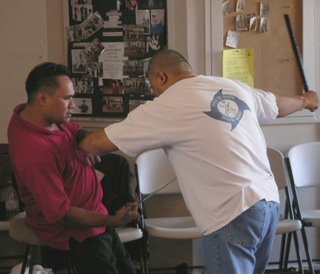
Jojo Soriben, another old protegé of grandmaster Angel Cabales, showing classic Serrada technique

Group Photo. Guro Bob Manalo and some IESA members dropped by earlier to pay respects, and Master Wade Williams was also there part of the afternoon.
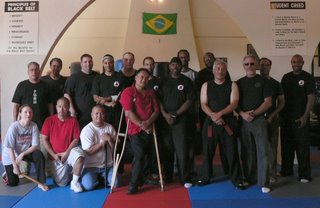
Instructors: Jojo Soriben on the far left, Serrada Master Ron Saturno on the far right; sponsor Professor James Hundon standing to the right of Carlito. Two of Carlito's talented students, standing behind him and on his right side next to Jojo.
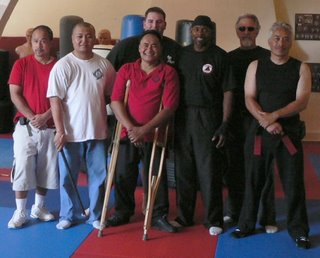

Jojo Soriben, another old protegé of grandmaster Angel Cabales, showing classic Serrada technique

Group Photo. Guro Bob Manalo and some IESA members dropped by earlier to pay respects, and Master Wade Williams was also there part of the afternoon.

Instructors: Jojo Soriben on the far left, Serrada Master Ron Saturno on the far right; sponsor Professor James Hundon standing to the right of Carlito. Two of Carlito's talented students, standing behind him and on his right side next to Jojo.

Drumming and Martial Arts
Sound has always been held sacred. The bible says that in the beginning was the word, the eminance of creation. The Hindus believe “OM” to be that primal sound of the universe. Starting in the late 1950’s, Dr. Hans Jenny conducted a series of experiments that became the science of cymatics. Using an oscillator, resonator plate and materials such as sand or metal filings, he demonstrated how various frequencies would vibrate the materials into semblances of organic forms, sometimes even creating pulsating three-dimensional figures.
The implication is that life follows vibrational patterns of resonance, and is responsive to the sound waves of the environment. We know that music can affect the emotions, from elevating the spirit to creating sadness. Exposure to loud or chaotic sound can weaken the body and lower resistance of the immune system. Amplified music is used to break prisoners’ wills, and by the military to psychologically assault fortified positions. New experiments are being done with focused sound waves as weapons, much as the laser uses focused, amplified light.
Shamanic traditions from around the world have used drumming to alter states of consciousness, drawing inspiration from natural sources such as thunder, water or wind. The feeling of a rhythmic beat can affect our physiology from trance-like states to exhilleration and action. Studies on the effects of drumming and changing have led to what are now known as binary beats. This refers to a subtle vibration between two frequencies that are close together, usually about 10hz. apart. These align the left and right hemispheres of the brain to duplicate meditative states at different levels of consciousness, ranging from alpha brain waves down to theta.
Martial arts and sound have an association that go back to earliest times. From the war cry to drumming, sound has been a way to focus energy of the mind and body as one. Drumming has a particular resonance that carries across distance and vibrates the body, with the unique ability to connect many as one. The source of the sound can be secondary, such as the cadence of feet marching in unison, or as portentious as the thunder of galloping hoofbeats. More deliberately, drums have been used to unify the will and fortify the courage of one’s own troops while intimidating the enemy with implied power.
On a specific level, drumming is about timing and focus, which should be of interest to martial artists. Because it involves striking, it has implications that go beyond that of any other instrument except the breath. I learned long ago not to slap box with conga players, whose hands are trained to strike endlessly with focus and power.
A friend related a story to me many years ago about something he witnessed at a classical Indian music concert. The legendary tabla master Allarakha Khan was annoyed by a microphone stand too close to his drums. Without missing a beat he tapped it back, but the focus of the hit was so precise that the metal stand snapped in half rather than pushing away. This is a feat that any iron palm master would do well to replicate.
The great Japanese swordsman Musashi was also a renowned painter. He claimed the sword gave his brush a bold stroke, while the brush gave him control to the tip of his weapon. For those of us who train with weapons, learning to play a drum kit would be a similar logical extension of our martial art. One learns to hit endlessly with relaxed power, and controlling the small tip of a drumstick can only enhance accuracy with larger weaponry.
Furthermore, it is aerobic exercise. Drumming involves the whole body, training hands and feet to move in precise relationship, and like martial arts, basic stepping with the feet supports hands that move quickly in multiple directions to accurately strike targets for specific intended effects.
Like martial arts, the essence of drumming is flow. At first there is a learning curve as one discovers the many simple details that must be mastered. Once the unconscious mind overcomes inhibitions and can handle those functions autonomically, then one can begin to think creatively, using those skills as tools for self-expression. Once again, a punch becomes just a punch.
I believe it was Goju master Cat Yamaguchi who said he wouldn’t teach a student who couldn’t dance, because the inner sense of rhythm is so important. Some martial arts practice to drumming or other instruments. In Capoeira, for instance, the music determines the rhythm of the fight, and the Capoerista learns to sit behind the drum as well as dance in front of it.
Of course one needn’t invest in a drum set to begin drumming. Tables, chairs, even one’s own body can provide resonance and resistance, all one really needs. Ordinary objects have been used as instruments around the world, from the clapping and table drumming of flamenco to spoons and washboards of early American music.
Meanwhile, listen to the sounds of the world around you, the source of much musical inspiration from tribal whistles to modern jazz. Hear the rhythms in martial arts, from breathing to footsteps, blocks and strikes, even the rustling of clothes and the sounds of spectators or other players. As martial artists we develop sensitivity to our environment through sensory perception. We learn to see and to feel, but how many of us learn to listen? Drumming can be a doorway to that world.
The implication is that life follows vibrational patterns of resonance, and is responsive to the sound waves of the environment. We know that music can affect the emotions, from elevating the spirit to creating sadness. Exposure to loud or chaotic sound can weaken the body and lower resistance of the immune system. Amplified music is used to break prisoners’ wills, and by the military to psychologically assault fortified positions. New experiments are being done with focused sound waves as weapons, much as the laser uses focused, amplified light.
Shamanic traditions from around the world have used drumming to alter states of consciousness, drawing inspiration from natural sources such as thunder, water or wind. The feeling of a rhythmic beat can affect our physiology from trance-like states to exhilleration and action. Studies on the effects of drumming and changing have led to what are now known as binary beats. This refers to a subtle vibration between two frequencies that are close together, usually about 10hz. apart. These align the left and right hemispheres of the brain to duplicate meditative states at different levels of consciousness, ranging from alpha brain waves down to theta.
Martial arts and sound have an association that go back to earliest times. From the war cry to drumming, sound has been a way to focus energy of the mind and body as one. Drumming has a particular resonance that carries across distance and vibrates the body, with the unique ability to connect many as one. The source of the sound can be secondary, such as the cadence of feet marching in unison, or as portentious as the thunder of galloping hoofbeats. More deliberately, drums have been used to unify the will and fortify the courage of one’s own troops while intimidating the enemy with implied power.
On a specific level, drumming is about timing and focus, which should be of interest to martial artists. Because it involves striking, it has implications that go beyond that of any other instrument except the breath. I learned long ago not to slap box with conga players, whose hands are trained to strike endlessly with focus and power.
A friend related a story to me many years ago about something he witnessed at a classical Indian music concert. The legendary tabla master Allarakha Khan was annoyed by a microphone stand too close to his drums. Without missing a beat he tapped it back, but the focus of the hit was so precise that the metal stand snapped in half rather than pushing away. This is a feat that any iron palm master would do well to replicate.
The great Japanese swordsman Musashi was also a renowned painter. He claimed the sword gave his brush a bold stroke, while the brush gave him control to the tip of his weapon. For those of us who train with weapons, learning to play a drum kit would be a similar logical extension of our martial art. One learns to hit endlessly with relaxed power, and controlling the small tip of a drumstick can only enhance accuracy with larger weaponry.
Furthermore, it is aerobic exercise. Drumming involves the whole body, training hands and feet to move in precise relationship, and like martial arts, basic stepping with the feet supports hands that move quickly in multiple directions to accurately strike targets for specific intended effects.
Like martial arts, the essence of drumming is flow. At first there is a learning curve as one discovers the many simple details that must be mastered. Once the unconscious mind overcomes inhibitions and can handle those functions autonomically, then one can begin to think creatively, using those skills as tools for self-expression. Once again, a punch becomes just a punch.
I believe it was Goju master Cat Yamaguchi who said he wouldn’t teach a student who couldn’t dance, because the inner sense of rhythm is so important. Some martial arts practice to drumming or other instruments. In Capoeira, for instance, the music determines the rhythm of the fight, and the Capoerista learns to sit behind the drum as well as dance in front of it.
Of course one needn’t invest in a drum set to begin drumming. Tables, chairs, even one’s own body can provide resonance and resistance, all one really needs. Ordinary objects have been used as instruments around the world, from the clapping and table drumming of flamenco to spoons and washboards of early American music.
Meanwhile, listen to the sounds of the world around you, the source of much musical inspiration from tribal whistles to modern jazz. Hear the rhythms in martial arts, from breathing to footsteps, blocks and strikes, even the rustling of clothes and the sounds of spectators or other players. As martial artists we develop sensitivity to our environment through sensory perception. We learn to see and to feel, but how many of us learn to listen? Drumming can be a doorway to that world.
Saturday, August 19, 2006
Sword Dances of India
I just saw this sword dance from India on Mushtaq Ali's blog. You might find it interesting, as is the rest of his blog, The Traceless Warrior (the link is on the column to the right).
I'd also suggest going to YouTube and doing search on gatka, a Sikh art from northern India. There's some good stuff there, like this tribute to Ustaad Bhai Charnjeet Singh.
I'd also suggest going to YouTube and doing search on gatka, a Sikh art from northern India. There's some good stuff there, like this tribute to Ustaad Bhai Charnjeet Singh.
Thursday, August 17, 2006
Modern Arnis Seminar in Burbank 9/17
Toma's Modern Arnis © presents a seminar with 8TH Dan Professor Danny Anderson, senior master instructor and founder, MA-80 System Of Modern Arnis, on Sunday September 17, 2006. Professor Anderson is also the author of a number of books and videos on Modern Arnis and Karate.
Wednesday, August 16, 2006
Upcoming Seminars
Master Wade Williams and Guro Carlito Bonjoc Jr. are two of the top proponents of Serrada Escrima, demonstrating and teaching this art at the highest levels. They will be presenting a two-day seminar in Antioch on September 23rd and 24th from noon-5pm.
Here's a reminder that Carlito will be doing a seminar in Oakland this coming Saturday, August 19th.
If you are interested in this compact, explosive art, I highly suggest you make it to these workshops!
************************************
Also this Saturday, from 9am to about noon, the U.S. Filipino Martial Arts Federation will be conducting a free seminar for tournament judges and referees at 4460 Hacienda Drive in Pleasanton, Ca.
(Map here)
(Directions here)
Those certified will be eligible to officiate in local and regional qualifying tournaments leading up to the national championships at the huge Disney World Martial Arts Festival The following links includes FMA contact info and the schedule for their Anaheim event Feb. 3&4, 2007.
This is open to all FMA styles.
Here's a reminder that Carlito will be doing a seminar in Oakland this coming Saturday, August 19th.
If you are interested in this compact, explosive art, I highly suggest you make it to these workshops!
************************************
Also this Saturday, from 9am to about noon, the U.S. Filipino Martial Arts Federation will be conducting a free seminar for tournament judges and referees at 4460 Hacienda Drive in Pleasanton, Ca.
(Map here)
(Directions here)
Those certified will be eligible to officiate in local and regional qualifying tournaments leading up to the national championships at the huge Disney World Martial Arts Festival The following links includes FMA contact info and the schedule for their Anaheim event Feb. 3&4, 2007.
This is open to all FMA styles.
Tuesday, August 15, 2006
The Benefit For Sonny
2006 has been a year of historic proportions for gatherings of the clans here in Northern California. This weekend marked another milestone as students and friends of ailing escrima master Sonny Umpad came together for the first time in a group for a benefit seminar on his behalf.
There were over 70 participants filling Nash’s Northern Tiger Kempo in San Francisco, a tribute to the esteem in which Sonny is held within the martial arts community. People came from all corners of the Bay Area and from a wide range of different arts (FMA, Wing Chun, Kempo, Hwarang-do) in order to show their support for one of the most innovative martial art teachers of our generation.
Attendees were rewarded with a strong showing by more than half a dozen of Sonny’s senior instructors. Their demonstrations of his Visayan Corto Cadena system covered a range from empty hands to sikaran (kicking), sticks, knives, bolos and swords. It was as thorough an exposition of Filipino martial arts as one might ever see, reflecting Sonny’s versatility in integrating so many facets within FMA.
Detailed attention was paid to Sonny’s “pendulum,” which uses dynamic Moro-based footwork to counter and evade. This is the basis for the sophisticated movement required for close quarter combat with the blade, representing a very high level of understanding timing and range.
Participants got a taste of some of these concepts in their workouts, and there were plenty of Sonny’s senior and advanced students to assist those who were more novice.
This was a warm and friendly crowd, all there to show support. Egos were checked at the door. I was particularly impressed with how the instructors got along, working together as a team and supporting each other. This too is a reflection of their maestro, for Sonny is a genuine and humble man who shares great talent freely with those around him.
If there was an off-note to the day, it was that Sonny himself was not feeling well enough to attend, spending the day at home with family and old friends, and his absence was the elephant in the room. In truth, this has been one of the hardest blogs for me to write. Most of the people there know and love Sonny, and all our prayers go towards his health.
Here are some of Sonny’s students who were there, listed simply by alphabetical order, not by seniority. My apologies to any whom I might have missed:
Chris Suboreau, Cisco Spano, Craig Merchant, Eric Momburg, George Yore, Gregory Manalo, Jason Santucci, Jay Pugao, Ken Ingram, Kevin and Felicia Baptiste, Maija Soderholm, Manny Piojo, Mike Braten, Phillip (Professor Pitt) Colas, Renato Alphonso, Steve Seto, Steve Van Manen.
Group photo at the end of the day
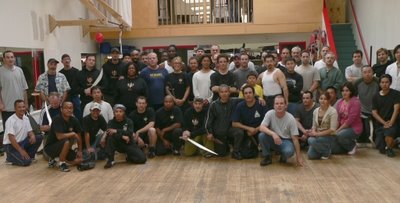
Instructors
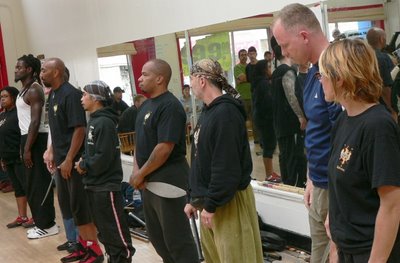
One of the devastating low kicking techniques of Sikaran

Passing the low slash of a knife (the basic counter for angle #4 in Serrada)

Targeting the knee with a low counter off an outside parry
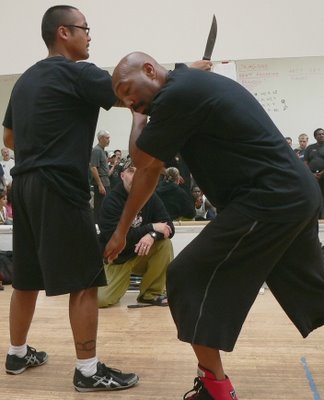
Fast work - getting in close with the long blades ...
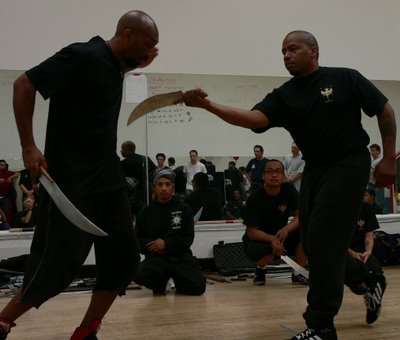

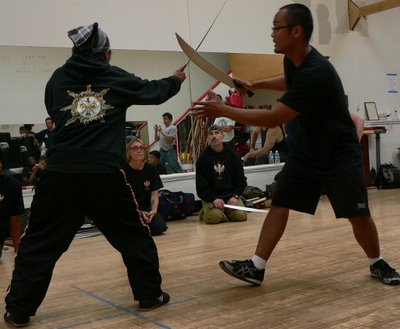

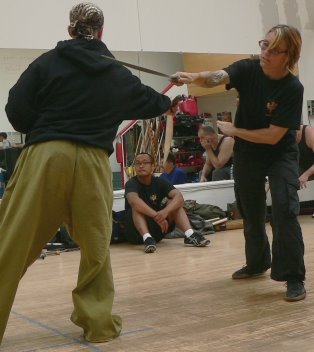

There were over 70 participants filling Nash’s Northern Tiger Kempo in San Francisco, a tribute to the esteem in which Sonny is held within the martial arts community. People came from all corners of the Bay Area and from a wide range of different arts (FMA, Wing Chun, Kempo, Hwarang-do) in order to show their support for one of the most innovative martial art teachers of our generation.
Attendees were rewarded with a strong showing by more than half a dozen of Sonny’s senior instructors. Their demonstrations of his Visayan Corto Cadena system covered a range from empty hands to sikaran (kicking), sticks, knives, bolos and swords. It was as thorough an exposition of Filipino martial arts as one might ever see, reflecting Sonny’s versatility in integrating so many facets within FMA.
Detailed attention was paid to Sonny’s “pendulum,” which uses dynamic Moro-based footwork to counter and evade. This is the basis for the sophisticated movement required for close quarter combat with the blade, representing a very high level of understanding timing and range.
Participants got a taste of some of these concepts in their workouts, and there were plenty of Sonny’s senior and advanced students to assist those who were more novice.
This was a warm and friendly crowd, all there to show support. Egos were checked at the door. I was particularly impressed with how the instructors got along, working together as a team and supporting each other. This too is a reflection of their maestro, for Sonny is a genuine and humble man who shares great talent freely with those around him.
If there was an off-note to the day, it was that Sonny himself was not feeling well enough to attend, spending the day at home with family and old friends, and his absence was the elephant in the room. In truth, this has been one of the hardest blogs for me to write. Most of the people there know and love Sonny, and all our prayers go towards his health.
Here are some of Sonny’s students who were there, listed simply by alphabetical order, not by seniority. My apologies to any whom I might have missed:
Chris Suboreau, Cisco Spano, Craig Merchant, Eric Momburg, George Yore, Gregory Manalo, Jason Santucci, Jay Pugao, Ken Ingram, Kevin and Felicia Baptiste, Maija Soderholm, Manny Piojo, Mike Braten, Phillip (Professor Pitt) Colas, Renato Alphonso, Steve Seto, Steve Van Manen.
Group photo at the end of the day

Instructors

One of the devastating low kicking techniques of Sikaran

Passing the low slash of a knife (the basic counter for angle #4 in Serrada)

Targeting the knee with a low counter off an outside parry

Fast work - getting in close with the long blades ...






Sunday, August 13, 2006
Spirituality in FMA
Someone posted the following quote on a martial art digest. Below is my response:
“People confuse filipino fighting arts with chinese and japanese arts. we are not founded by priests. we do not try to "make students better character", or "good people", that is what churches and mosques are for. FMA has one goal, to make good and effective fighters, to hurt people. you cannot do this in your mind or even at the drawing board. FMA has too many people with too many theories, not enough hands on.”
Yes and no. I certainly don't dispute the pragmatic goal of strong fighting skills as the raison d'etre for FMA training. As Master Han says in "Return of the Dragon", who knows how many treasures have been lost to the world because of the lack of the will to defend them. That statement, however, defines fighting skill as an outer level, whose purpose is as a shield to protect the inner. However, inner and outer are not separate but rather are part of each other by definition. A person empowered by their thoughts and beliefs will be stronger than one who is unsure or conflicted.
The power of the spirit was certainly known to Filipinos, the basis for practices like oracion and anting-anting. Before angles were known by numbers, they were taught by name association. Angle #1 was often called San Miguel because Saint Michael is depicted with an upraised sword of truth and justice, depicting that strike. Similarly, the Moros were feared not just for their fighting techniques, because Cebuanos and others proved equal in battle, but because it was the strength of their convictions that made them such formidable adversaries.
We may not think of murder and mayhem as spiritual, but even societies engaged in such practices have empowering belief systems. Viking beserkers were a terror across Europe, but they believed in Valhalla and an afterlife, which helped them conquer their fear of death.
It is said that one man's terrorist is another's freedom fighter. Is taking up arms spiritual? Depends which side of that equation you are on. Does it make you a better person? Anything that engages us completely is a transformative experience, which is why the samurai took so readily to Zen, understanding the power of having "one mind." Most modern FMA is taught in a niche of "practicality" but anyone who undertakes a process of change experiences it inwardly as well. The old manongs would sometimes hold their hand over the head of a prospective student to see if they were too "hot-headed" to be trusted with deadly knowledge. They were concerned with the character of their students just as many of us are today.
Esoteric knowledge of the inner self has always been secretive, not just as a way to control power but because the masses were not deemed awakened enough to understand. It takes time to develop someone to a level of understanding, and the repression of Filipino culture under the Spanish diminished this part as well. Martial arts typically in times of war are less concerned with niceties of personal development, and so the FMA became noted for straightforward practicality. Now we live in an era in which knowledge is much more open through literacy and mass communication.
I see no reason not to include deeper awareness through self-examination as part of a curriculum. It may not suit every student, and it isn't the first thing taught, but in my experience such self-understanding enables people to progress further than if they are dependent on others to give them knowledge. Mind-body integration happens regardless of intentionality, but awareness is more powerful than ignorance. The discipline to train the body comes from the mind, and this process develops the spirit and will to succeed. These are not separate things.
Now not every instructor will delve into this. Many may not have the ability to communicate what they themselves feel internally, and so it is only through the training that they lead others towards mastery. Make no mistake, though. Mastery is not just of the techniques, but of the self; polish the spirit and the results will be evident.
This connection is more prominent in many styles of Silat than FMA these days, but the similarity of the arts and cultural connections are a clue such awareness can be found in both. In the end, spirituality is the essence of each of us, not just something to be controlled by religious organizations. When we dedicate ourselves through effort, we elevate ourselves regardless of what it is we choose to do.
“People confuse filipino fighting arts with chinese and japanese arts. we are not founded by priests. we do not try to "make students better character", or "good people", that is what churches and mosques are for. FMA has one goal, to make good and effective fighters, to hurt people. you cannot do this in your mind or even at the drawing board. FMA has too many people with too many theories, not enough hands on.”
Yes and no. I certainly don't dispute the pragmatic goal of strong fighting skills as the raison d'etre for FMA training. As Master Han says in "Return of the Dragon", who knows how many treasures have been lost to the world because of the lack of the will to defend them. That statement, however, defines fighting skill as an outer level, whose purpose is as a shield to protect the inner. However, inner and outer are not separate but rather are part of each other by definition. A person empowered by their thoughts and beliefs will be stronger than one who is unsure or conflicted.
The power of the spirit was certainly known to Filipinos, the basis for practices like oracion and anting-anting. Before angles were known by numbers, they were taught by name association. Angle #1 was often called San Miguel because Saint Michael is depicted with an upraised sword of truth and justice, depicting that strike. Similarly, the Moros were feared not just for their fighting techniques, because Cebuanos and others proved equal in battle, but because it was the strength of their convictions that made them such formidable adversaries.
We may not think of murder and mayhem as spiritual, but even societies engaged in such practices have empowering belief systems. Viking beserkers were a terror across Europe, but they believed in Valhalla and an afterlife, which helped them conquer their fear of death.
It is said that one man's terrorist is another's freedom fighter. Is taking up arms spiritual? Depends which side of that equation you are on. Does it make you a better person? Anything that engages us completely is a transformative experience, which is why the samurai took so readily to Zen, understanding the power of having "one mind." Most modern FMA is taught in a niche of "practicality" but anyone who undertakes a process of change experiences it inwardly as well. The old manongs would sometimes hold their hand over the head of a prospective student to see if they were too "hot-headed" to be trusted with deadly knowledge. They were concerned with the character of their students just as many of us are today.
Esoteric knowledge of the inner self has always been secretive, not just as a way to control power but because the masses were not deemed awakened enough to understand. It takes time to develop someone to a level of understanding, and the repression of Filipino culture under the Spanish diminished this part as well. Martial arts typically in times of war are less concerned with niceties of personal development, and so the FMA became noted for straightforward practicality. Now we live in an era in which knowledge is much more open through literacy and mass communication.
I see no reason not to include deeper awareness through self-examination as part of a curriculum. It may not suit every student, and it isn't the first thing taught, but in my experience such self-understanding enables people to progress further than if they are dependent on others to give them knowledge. Mind-body integration happens regardless of intentionality, but awareness is more powerful than ignorance. The discipline to train the body comes from the mind, and this process develops the spirit and will to succeed. These are not separate things.
Now not every instructor will delve into this. Many may not have the ability to communicate what they themselves feel internally, and so it is only through the training that they lead others towards mastery. Make no mistake, though. Mastery is not just of the techniques, but of the self; polish the spirit and the results will be evident.
This connection is more prominent in many styles of Silat than FMA these days, but the similarity of the arts and cultural connections are a clue such awareness can be found in both. In the end, spirituality is the essence of each of us, not just something to be controlled by religious organizations. When we dedicate ourselves through effort, we elevate ourselves regardless of what it is we choose to do.
Wednesday, August 09, 2006
Kajukenbo Ohana Seminar this Saturday!
Prof. Greg Lagera (Kajukenbo 8th Dan) is having an all-day seminar (which includes lunch) from 9-6 on Saturday in Newark, in the East Bay between Hayward and San Jose. This 8-Hour workout will include Kajukenbo Self-Defense, Filipino Martial Arts, Jeet Kune Do, Kickboxing, Submission Grappling, and Live Sparring.
(Open to all ages and skill levels.)
Some of the best martial arts instructors anywhere will be attending, such as grandmasters Al Novak, Ted Sotelo, Emil Bautista and more. I've known Greg Lagera since he and my Kenpo teacher were top competitors at tournaments in the 1980's. Cost is $45 at the door, but for an event of this caliber (and lunch) it's a steal!
For those who are not familiar with Kajukenbo, it is a highly effective street-fighting system incorporating a number of different root systems, including escrima, so you might find it an effective transition from weapons to empty hands.
Take 880 and exit at Thorton Ave. going west (towards the Bay, away from the hills). Turn right on Mayhews Landing (about 1/2 mile; 2 lights), which will curve left, and then right on Cherry. The event is in the park at Cherry and Montcalm.
(Open to all ages and skill levels.)
Some of the best martial arts instructors anywhere will be attending, such as grandmasters Al Novak, Ted Sotelo, Emil Bautista and more. I've known Greg Lagera since he and my Kenpo teacher were top competitors at tournaments in the 1980's. Cost is $45 at the door, but for an event of this caliber (and lunch) it's a steal!
For those who are not familiar with Kajukenbo, it is a highly effective street-fighting system incorporating a number of different root systems, including escrima, so you might find it an effective transition from weapons to empty hands.
Take 880 and exit at Thorton Ave. going west (towards the Bay, away from the hills). Turn right on Mayhews Landing (about 1/2 mile; 2 lights), which will curve left, and then right on Cherry. The event is in the park at Cherry and Montcalm.
Tuesday, August 08, 2006
Tales from Hurricane Katrina
My first college roommate lived in Bay St. Louis, a paradise that was ground zero for Hurricane Katrina. He just sent me a link to these gripping tales, written by a town survivor, detailing the horrors of the hurricane and its aftermath there and in New Orleans. Absolutely riveting ... and a cautionary tale for anyone expecting help to arrive. As one policeman told a woman there, she "might be standing on American soil, but it wasn’t America any more."
Here's a blog about battling insurers and bureaucrats to rebuild. As the author writes, ten months after the hurricane "some relief workers who had been working on the December 2004 Asian Tsunami relief effort toured New Orleans and were shocked that so little had been done. They concluded that in Third World countries such as Indonesia, the people weren't hindered by government agencies and the insurance industry." It's sad how things are run here nowadays. And scary.
Here's a blog about battling insurers and bureaucrats to rebuild. As the author writes, ten months after the hurricane "some relief workers who had been working on the December 2004 Asian Tsunami relief effort toured New Orleans and were shocked that so little had been done. They concluded that in Third World countries such as Indonesia, the people weren't hindered by government agencies and the insurance industry." It's sad how things are run here nowadays. And scary.
Monday, August 07, 2006
Sonny Umpad Benefit Seminar This Sunday!
On the thirteenth of this month, students of Master Sonny Umpad
will be holding a seminar/ benefit on his behalf.
Senior students from every generation will be represented, teaching
the unique aspects of Visayan Eskrima. There will be many teachers
on hand to help further your understanding of this art.
This is truly a once in a lifetime opportunity as the students of
Master Umpad , come together to share his style of eskrima.
Where:
John Nash, Northern Tiger Kempo
1319, 20th ave (at Irving)
SF, CA 94122 When:
August, 13 2006 from noon to four $50 dollars at the door (cash only)
You must supply your own training weapons.
will be holding a seminar/ benefit on his behalf.
Senior students from every generation will be represented, teaching
the unique aspects of Visayan Eskrima. There will be many teachers
on hand to help further your understanding of this art.
This is truly a once in a lifetime opportunity as the students of
Master Umpad , come together to share his style of eskrima.
Where:
John Nash, Northern Tiger Kempo
1319, 20th ave (at Irving)
SF, CA 94122 When:
August, 13 2006 from noon to four $50 dollars at the door (cash only)
You must supply your own training weapons.
Wedges
Everyone here is probably familiar with triangle stepping and angles. I constantly remind students that the FMA logo (triangle in circle) is not just symbolic, but also a more literal roadmap.
This is always shown with the "male triangle" which points up or forward. Forward usually means towards the opponent's centerline, but it can also mean facing the strongest point of his attack. Situations vary. Rotated, of course, into the female position, the points demonstrate angles of evasion.
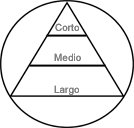
Points are strong, being reinforced. Lines are strong in direction of movement from point to point. They are vulnerable, however, across their width. Think of a pencil; strong one way, weak the other.
Inside the triangle's lines lies our safe zone. Outside the triangle increases exposure. An example is doing a cross-block (a downward pointing defense on our check-hand side) but leaving our rear elbow or shoulder exposed wide, outside the angle of protection afforded by the defense.
The closer we get to the point, the tighter the lines and smaller the area we have to move to stay within them, yet the angles themselves are the same degrees of arc at any range.
This is a key essence of Serrada. We want to find the smallest, tightest range at which we can function. It represents our last line of defense, what is closest to us.
Functionality is, of course, the key. Too much compression could be immobilizing or collapse. Some might think it lacks power because there is less room to accelerate. Understanding fulcrums and balance, however, gives us full measure. In every technique I seek to apply GM Ed Parker's three maxims for power: linear, rotational, gravity.
Al Thomas, my original Kenpo teacher, used to remind us of the magnifying effect of adrenaline. His point was if we train like a golf ball, we'll fight like a baseball; train like a baseball, fight like a basketball; train like a basketball, we'll fight like a beachball. In other words, we open ourselves up under stress. By training more tightly, that habit tends to remain more effective when it's most needed.
A basketball isn't a bad area of protection for the body, but a beachball is excessive movement. It it too much volume of space to protect and takes too long to finish a movement. Even largo mano (long range) techniques tend to hit pretty directly to the target. No matter what style you do, nothing matters until "point of impact" (POI) anyway, and so we want to maximize our effectiveness there, whether we hit and run or jam and control.
Range is a basic tactical choice, but efficiency is even more fundamental. It allows us more time to observe our opponent and to engage less telegraphically.
Like a sine wave, greater ranges involve more momentum whereas closer ranges increase frequency though the energy can remain a constant (how a whip accelerates and cracks, for instance). Top speed is traded for speed of reversal, and to a certain extent power might be traded for accuracy (though expert proponents can demonstrate otherwise).
Closer ranges have different risks. There are fewer weapons to monitor at longer ranges. As one moves in, the opposing hand can strike, then grab, then envelop or encircle. One needs to be as aware of one's own vulnerable targets as is attention to the opponent.
Once again we have our "threat triangle" to monitor, and this has been a reminder to keep everything protected within it, both front and rear sides of your body. Pay attention, as you move your guard towards or or away from your opponent, how it will open and close different areas relative to your opponent's weapon and centerline.
In this diagram we stand in the center of our circle/triangle, which is the point to which our opponent reaches. The back half is our largo range where we move our vital targets out of reach.
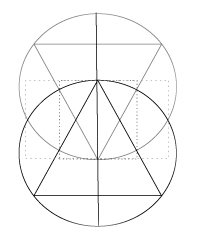
This might be redundant to many, and others may not want to dig through the archives anyway. Regardless, it's always good practice to review fundamental concepts, refreshing the touchstone from which we measure our understanding and progress.
This is always shown with the "male triangle" which points up or forward. Forward usually means towards the opponent's centerline, but it can also mean facing the strongest point of his attack. Situations vary. Rotated, of course, into the female position, the points demonstrate angles of evasion.

Points are strong, being reinforced. Lines are strong in direction of movement from point to point. They are vulnerable, however, across their width. Think of a pencil; strong one way, weak the other.
Inside the triangle's lines lies our safe zone. Outside the triangle increases exposure. An example is doing a cross-block (a downward pointing defense on our check-hand side) but leaving our rear elbow or shoulder exposed wide, outside the angle of protection afforded by the defense.
The closer we get to the point, the tighter the lines and smaller the area we have to move to stay within them, yet the angles themselves are the same degrees of arc at any range.
This is a key essence of Serrada. We want to find the smallest, tightest range at which we can function. It represents our last line of defense, what is closest to us.
Functionality is, of course, the key. Too much compression could be immobilizing or collapse. Some might think it lacks power because there is less room to accelerate. Understanding fulcrums and balance, however, gives us full measure. In every technique I seek to apply GM Ed Parker's three maxims for power: linear, rotational, gravity.
Al Thomas, my original Kenpo teacher, used to remind us of the magnifying effect of adrenaline. His point was if we train like a golf ball, we'll fight like a baseball; train like a baseball, fight like a basketball; train like a basketball, we'll fight like a beachball. In other words, we open ourselves up under stress. By training more tightly, that habit tends to remain more effective when it's most needed.
A basketball isn't a bad area of protection for the body, but a beachball is excessive movement. It it too much volume of space to protect and takes too long to finish a movement. Even largo mano (long range) techniques tend to hit pretty directly to the target. No matter what style you do, nothing matters until "point of impact" (POI) anyway, and so we want to maximize our effectiveness there, whether we hit and run or jam and control.
Range is a basic tactical choice, but efficiency is even more fundamental. It allows us more time to observe our opponent and to engage less telegraphically.
Like a sine wave, greater ranges involve more momentum whereas closer ranges increase frequency though the energy can remain a constant (how a whip accelerates and cracks, for instance). Top speed is traded for speed of reversal, and to a certain extent power might be traded for accuracy (though expert proponents can demonstrate otherwise).
Closer ranges have different risks. There are fewer weapons to monitor at longer ranges. As one moves in, the opposing hand can strike, then grab, then envelop or encircle. One needs to be as aware of one's own vulnerable targets as is attention to the opponent.
Once again we have our "threat triangle" to monitor, and this has been a reminder to keep everything protected within it, both front and rear sides of your body. Pay attention, as you move your guard towards or or away from your opponent, how it will open and close different areas relative to your opponent's weapon and centerline.
In this diagram we stand in the center of our circle/triangle, which is the point to which our opponent reaches. The back half is our largo range where we move our vital targets out of reach.

This might be redundant to many, and others may not want to dig through the archives anyway. Regardless, it's always good practice to review fundamental concepts, refreshing the touchstone from which we measure our understanding and progress.
Subscribe to:
Comments (Atom)
